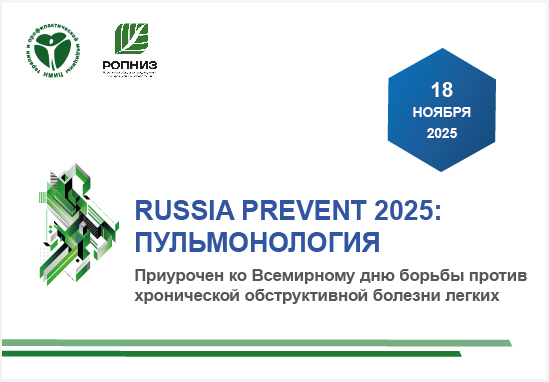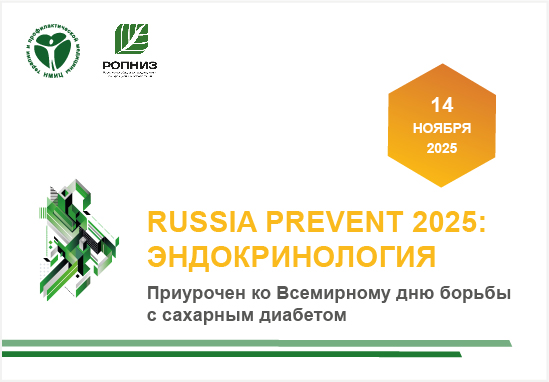TOBACCO DEPENDENCE TREATMENT WITH NICOTINE REPLACEMENT THERAPY AS ONE OF THE METHODS FOR CARDIOVASCULAR DISEASE RISK REDUCTION
https://doi.org/10.20996/1819-6446-2005-1-1-24-30
Abstract
Aim. To investigate efficacy and safety of nicotine chewing gum and inhaler in individuals trying to quit smoking. To assess expected reduction of cardiovascular disease (CVD) and total mortality relative risks (RR).
Material and methods. In this open, parallel study, 169 relatively healthy male smokers aged 18-60 years were randomly assigned to free choice vs admission of Nicorette gum (2/4 mg) or inhaler (10 mg). At baseline, all participants smoked ≥15 cig/d, for ≥3 years. The intervention phase lasted 3 months; follow-up evaluations were made at 3, 6 and 12 months after nicotine replacement therapy (NRT) initiation.
Results. Twelve-month results were obtained for 152 subjects (response rate 89.9%). Point prevalence abstinence and reduction (smoking ≤50% of basic daily cigarette amount) rates were 19.7% and 35.5%, respectively. Neither abstinence, nor reduction rates depended on Nicorette form (gum vs inhaler), or on choice vs admission factor. The main predictors of long-term efficacy were nicotine dependence severity and contacts with other smokers.
NRT was not associated with negative dynamics in objective health parameters (blood pressure, heart rate, ECG parameters, body weight, and body mass index) or self-evaluation of health. Both Nicorette forms seemed to be safe and well-tolerated.
At 12 months, the expected mean RR reduction for CVD mortality reached 19%, for total mortality – 21%.
Conclusion. In Russian clinical settings, NRT efficacy and safety are similar to that demonstrated in numerous international trials. NRT can be recommended as one of the methods of assistance to quit smoking and, therefore, for CVD risk reduction.
About the Authors
O. V. VikhirevaRussian Federation
S. A. Shalnova
Russian Federation
A. D. Deev
Russian Federation
References
1. Оганов Р.Г., Деев А.Д., Жуковский Г.С., и др. Влияние курения на смертность от хронических неинфекционных заболеваний по результатам проспективного исследования. Профилактика заболеваний и укрепление здоровья 1998;3:13-5.
2. Peto R, Lopez AD, Boreham J, et al. Mortality from smoking worldwide. Br Med Bull 1996;52(1):12-21.
3. Duthie GG, Arthur JR, Beattie JA, et al. Cigarette smoking antioxidants, lipid peroxidation, and coronary heart disease. An N Y Acad Sci 1993;686:120-9.
4. Campisi R, Czernin J, Schoder H, et al. Effects of long-term smoking on myocardial blood flow, coronary vasomotion and vasodilator capacity. Circulation 1998;98:119-25.
5. Benowitz NL, Fitzgerald GA, Wilson M, Zhang Q. Nicotine effects on eicosanoid formation and hemostatic function: comparison of transdermal nicotine and cigarette smoking. J Am Coll Cardiol 1993;22(4):1159-67.
6. Czernin J, Sun K, Brunken R, et al. Effect of acute and long-term smoking on myocardial blood flow and flow reserve. Circulation 1995;91:2891.
7. Dawber TR. The Framingham Study: The Epidemiology of Atherosclerotic Disease. Chapter 8. Cambridge, MA: Harvard University Press, 1980.
8. U.S. DHHS (US Department of Health and Human Services). The health consequences of smoking: nicotine addiction. A report of the Surgeon General. Atlanta (GA): US Department of Health and Human Services. Public Health Service, Centers for Disease Control, Center for Chronic Disease Prevention and Health Promotion, Office of Smoking and Health. DHHS Publication No. (PHS) (CDC) 88-8406, 1988.
9. Wilhelmsen L. Coronary heart disease: Epidemiology of smoking and intervention studies of smoking. Am Heart J 1988;115:242-9.
10. Kawachi I, Colditz GA, Stempfer MJ, et al. Smoking cessation and decreased risk of total mortality, stroke, and coronary heart disease incidence in women: A prospective cohort study. National Cancer Institute. Changes in Cigarette-Related Disease Risks and Their Implications for Prevention and Control. NCI Smoking and Tobacco Control Monograph 8. 1997. Washington, DC: NCI. Pp. 531-65.
11. Thun MJ, Myers DG, Day-Lally C, et al. Age and exposure-response relationships between cigarette smoking and premature death in cancer prevention study II. National Cancer Institute. Changes in Cigarette-Related Disease Risks and Their Implication for Prevention and Control. NCI Smoking and Tobacco Control Monograph 8. Washington, DC: NCI. 1997. Pp. 383-475.
12. U.S. DHHS (U.S. Department of Health and Human Services). The Health Consequences of Smoking: 25 Years of Progress. A Report of the Surgeon General. Chapter 8. Washington, DC: DHHS Publications, 1989.
13. Hankey GJ. Smoking and risk of stroke. J Cardiovasc Risk 1999;6:207-11.
14. Reed DM, MacLean CJ, Hayashi T. Predictors of atherosclerosis in the Honolulu Heart Program: I. Biologic, dietary and lifestyle characteristics. Am J Epidemiol 1987;126:214-25.
15. Hughes JR. Four beliefs that may impede progress in the treatment of smoking. Tob Control 1999;8:323-6.
16. U.S. DHHS (U.S. Department of Health and Human Services). The health consequences of smoking: Cardiovascular Disease. Chapter 8. Washington, DC: DHHS Publications, 1983.
17. Rosenberg L, Kaufman DW, Helrich SP, et al. The risk of myocardial infarction after quitting smoking in men under 55 years of age. N Engl J Med 1985;313:1511-4.
18. Rivers JT, White HD, Cross DB, et al. Reinfarction after thrombolytic therapy for acute myocardial infarction followed by conservative management: Incident and effect of smoking. J Am Coll Cardiol 1990;16:340-8.
19. Wilson K, Gibson N, Willan A, Cook D. Effect of smoking cessation on mortality after myocardial infarction: meta-analysis of cohort studies. Arch Intern Med 2000;160:939-44.
20. World Health Organization. International statistical classification of diseases and related health problems (ICD-10). 10th rev. Ed., vol. 1. Geneva: World Health Organization, 1992.
21. Raw M, McNeill A, West R. Smoking cessation guidelines for health professionals. Thorax 1998;53 Suppl.5:1-18.
22. Silagy C, Mant D, Fowler G, Lancaster T. Nicotine replacement therapy for smoking cessation. In: Cochrane Collaboration. Cochrane Library. Issue 3. Oxford: Update Software, 1999.
23. Fiore MC, Baily WC, Cohen SJ, et al. Treating Tobacco Use and Dependence. Clinical Practice Guideline. Rockville, MD: U.S. Department of Health and Human Services. Public Health Service. June 2000.
24. Lancaster T, Stead LF. Individual behavioural counselling for smoking cessation. In: Cochrane Collaboration. Cochrane Library. Issue 3. Oxford: Update Software, 2000.
25. Сарсенова С.И. Сравнительное изучение эффективности немедикаментозных и медикаментозных методов прекращения ку- рения в амбулаторных условиях. Автореф. дис. …канд. мед. наук. М 1993; 27 с.
26. Левшин В.Ф. Проблема табакокурения и пути ее решения. Курение или здоровье в России? Серия докладов по политике в области охраны здоровья населения «Здоровье для всех – все для здоровья» под ред. А. К. Демина. - М.-1996.-№3.-С.157-212.
27. Чучалин А.Г., Сахарова Г.М., Новиков К.Ю. Практическое руководство по лечению табачной зависимости. РМЖ 2001;9(21):904-10.
28. Чучалин А.Г., Сахарова Г.М. Практическое применение программ по лечению табачной зависимости. РМЖ 2002;10(4):149-53.
29. Fagerstrom KO. Measuring degree of physical dependence to tobacco smoking with reference to individualization of treatment. Add Behav 1978;3:235-41.
30. SAS/STAT User's Guide, Version 6, Fourth Edition, Vol.1 & 2, SAS Institute Inc., Cary, NC, USA, -1990.
31. Шальнова С.А. Факторы риска сердечно-сосудистых заболеваний и показатели ожидаемой продолжительности жизни населения России. Дис. … докт. мед. наук. М 2000; 191 с.
32. Деев А.Д., Школьников В.М. Неоднородность смертности: анализ индивидуальных данных. Влияние поведенческих факторов риска. Неравенство и смертность в России: коллективная монография. Под ред. В. Школьникова, Е. Андреева и Т. Малевой; Моск. Центр Карнеги. – М.:Сигналъ, 2000. – 107 с. С. 63-73.
33. Российский статистический ежегодник. 2002. Стат. сб. / Госкомстат России. – М., 2002. – 690 с.
Review
For citations:
Vikhireva O.V., Shalnova S.A., Deev A.D. TOBACCO DEPENDENCE TREATMENT WITH NICOTINE REPLACEMENT THERAPY AS ONE OF THE METHODS FOR CARDIOVASCULAR DISEASE RISK REDUCTION. Rational Pharmacotherapy in Cardiology. 2005;1(1):24-30. (In Russ.) https://doi.org/10.20996/1819-6446-2005-1-1-24-30















































